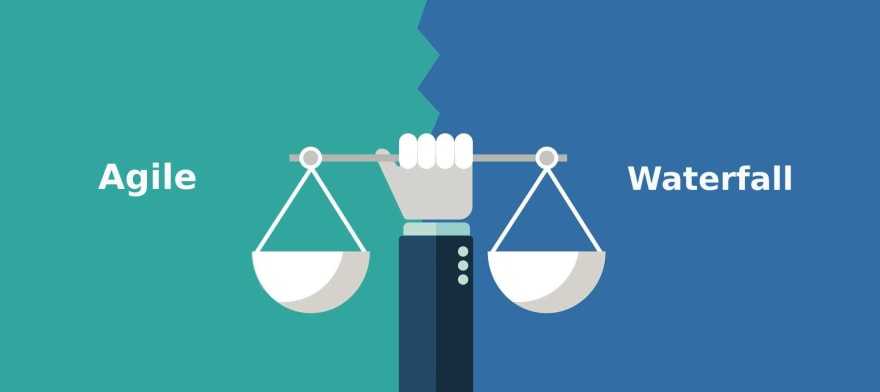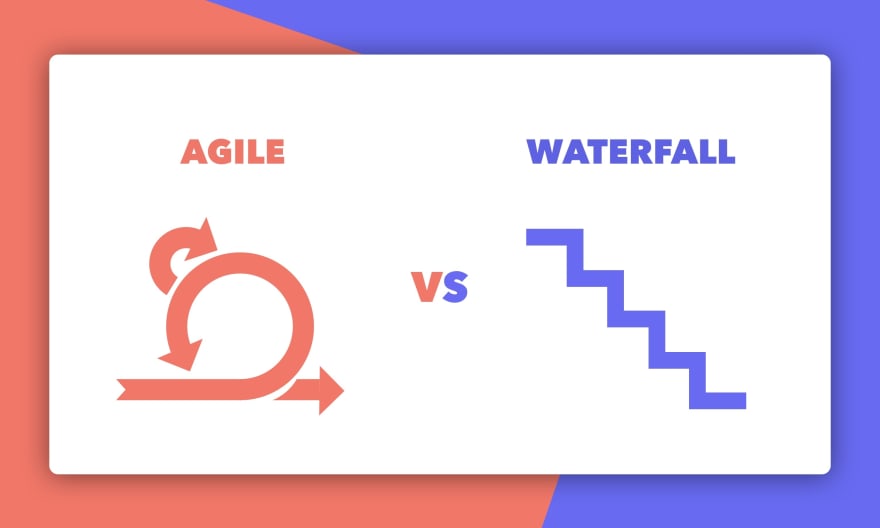Before undertaking a project, development teams have to decide how to approach it. Making this decision can become heated due to the two basic development methodologies. In fact, these methodologies define how the actual tasks of a project are organized and acted on.
In 2021, we still have to face the eternal question of which methodology is better - Waterfall or Agile. Both approaches are typically applied to software development, and thus, project management as well.
What is the difference between Waterfall and Agile? The key difference between Agile and Waterfall is that Waterfall projects are completed sequentially while Agile-oriented projects are completed iteratively in a cycle.
If this brief explanation is enough for your final choice, then then you can click on any other post. However, this matter is not so simple.
Is Agile better than Waterfall? Is Waterfall better than Agile? There is no clear answer to these questions, as, of course, each team decides in its own way, making its own arguments in defense of one or the other approach.
Both methods carry their own set of pros and cons. Overall, both Waterfall and Agile can be beneficial to a software development team. The final choice is highly dependent on the project type and circumstances.
Let's start from the basics and then delve into some essential points that will help you to see the differences between both approaches and choose a favorite in the eternal confrontation "Waterfall versus Agile".
Waterfall Definition: What is the Waterfall Methodology?
The Waterfall traditional method is a linear approach to development based on strict planning and performing plans step by step. Companies with a hierarchical structure usually prefer it.
In order to work with this method, you'll have adhered to the following sequence of events:
- to gather and document requirements.
- to let the customer be involved in the project performance only at the first and the last stage.
- to design, when developers try to find a suitable form to meet all the customer’s requirements.
- to test codes and unites.
- to test the system and user acceptance.
- to fix issues.
- to deliver the finished product to the customer.
Usually, every phase finishes before the next one can begin. Besides, there is a stage-gate between each. For example, a customer must review and approve requirements before design begins.
What are the Waterfall pros?
- Waterfall is one of the easiest models to manage.
- The approach provides a clear understanding of your project timeline and deliverables before the project begins.
- It works well for small-sized projects with easily understandable requirements.
- It provides faster project delivery.
- Developers and clients can agree on what will be delivered early in the development lifecycle that is why planning and designing look straightforward.
- Progress is more easily measured because the full scope of the work is known in advance.
- Waterfall offers well-documented processes and results.
- It provides a shared load when each team member can focus on other aspects of their work, depending on the stage.
- It is easily adaptable for shifting teams.
What are the Waterfall cons?
- Waterfall is not the best solution for large-size projects.
- It has quite a rigid structure to allow necessary changes.
- It looks less effective if requirements are not clear at the very beginning.
- Testing is done only at the later phases of the project.
- It is not easy to move back to make changes in the previous stages.
- Waterfall provides less customer involvement and limited customer engagement.
Agile Definition: What is the Agile Methodology?
Agile is a popular team-based approach that emphasizes rapid deployment of a functional application and focused on customer satisfaction. The method contains a sprint - a time-boxed phase with a defined duration of two weeks. All deliverables are prioritized based on customer input at the start of each sprint. And at the end of the sprint, teams, and customers review and evaluate the work for future sprints.
Agile software development includes various flows that share some basic similarities (Extreme Programming, Kanban, Scrum, Lean software development, and Agile Unified Process).
Agile contains two significant elements: teamwork and time. Here are the main principles of Agile development:
- Adaptability
- -Teamwork
- Lean development
- Customer involvement
- Small units of time
- Sustainability
- Testing through every phase of the project
What are the pros of Agile?
- Agile is about a faster software development life cycle.
- It is focused on the client process and ensures that your clients are continuously involved in every stage.
- Agile is flexible in accepting changes.
- It offers a predictable schedule in sprints.
- It ensures the quality of the development and its maintenance.
- It promotes efficient communications and empowers team members to manage projects.
- The methodology looks ideal for projects with non-fixed funding.
- Agile teams are extremely motivated and self-organized.
- Customers can provide feedback after each sprint.
What are the cons of Agile?
- Agile requires a high degree of customer involvement. However, not all clients are comfortable with this fact.
- The method can weaken the principle of self-management, as it assumes every team member is completely dedicated to the project.
- For better communication, it recommends co-location that is not always possible.
- It may seem not useful for small development projects.
- In case when PMs are not sure what outcome they want, the Agile project can easily go off track.
- Agile meetings run better with the expert to take important decisions but it is also not always possible.
- Agile implementation costs more than other methodologies.
Agile vs Waterfall: What is the Difference Between Waterfall and Agile Approaches?
Let's highlight some of the distinct differences.
- Agile is famous for its incremental and iterative approach. Waterfall is a linear and sequential methodology.
- Agile will help you with completing numerous small projects. Waterfall will help with completing one single project.
- Agile focuses on customer satisfaction. Waterfall is mostly focused on efficient project delivery.
- Agile divides projects into sprints. The traditional Waterfall method separates projects into phases.
- In Agile, requirements are prepared daily. In the traditional approach, requirements are prepared once at the start.
- You may change requirements at any time in Agile. According to Waterfall, scope changes are allowed once the project starts.
- In Agile, the testing phase is performed concurrently with development. In Waterfall, testing comes only after the build phase.
- Agile test teams are allowed to take part in requirements change. Waterfall testing teams are not involved in the requirements change process.
- In Agile, the team is able to manage projects without a dedicated project manager. Waterfall projects require a PM to play an essential role on every stage.
Can Waterfall and Agile be used together?
Agile PM methodologies can be actually used for any development project and they often provide some great benefits. However, there are vivid situations where more traditional methods like Waterfall look better.
Complex enterprise-wide development where users are being led through a standardized process is completed more efficiently with Waterfall. Teams that work on developing mobile applications, which must be highly flexible and quickly updated will likely find Agile more powerful and reliable.
However, many projects are not completely black or white in the PM reality. They can benefit most from a hybrid project management approach that includes advantages of both Agile and Waterfall. This is about blending the best of both concepts.
How Do You Choose Agile or Waterfall?
Making the choice between Agile vs Waterfall is not an easy thing as far as you can see.
Which development methodology you go with depends on several important factors. If there is no access to a customer to provide constant feedback (or it is limited), - then waterfall is objectively the right choice. It will suit projects with a dispersed team, fixed scope, and budget.
Agile looks more appropriate for more complex projects, where you can get easy access to customer feedback. Thanks to its flexibility, Agile is preferred for projects with constantly changing requirements.
In recent years, Agile became the predominant development approach, being used by the majority of development companies.
Is Agile really better than Waterfall?
Tastes differ. Many admit that the worst things about Waterfall are trouble managing requirements, wasted time, adapting to changing needs. So it can be expensive and hard to manage. At the same time, developers may feel frustrated that they’re not getting valuable experience working in an Agile company.
Even developers who are still using Waterfall tend to implement a hybrid approach using both methodologies' advantages. Despite the real success of Agile, the traditional method still looks valid in certain circumstances.
FAQ
What is the difference between Waterfall and Agile?####
Waterfall projects are completed sequentially while Agile projects are completed iteratively in a cycle.
Why Agile is preferred over Waterfall?
Agile offers shorter planning based on iterations and multiple deliveries. It assumes a collaborative and interactive approach to requirements. According to the approach, changes in deliverables are expected and less impactful. Customers can be involved throughout the sprint. Agile suits more complex projects, where you can get easy access to customer feedback.
Is SDLC Waterfall or Agile?
The SDLC (Software Development Life Cycle) models' diversity is defined by the numerous product types, starting with a simple website to complex software solutions. The most popular and important SDLC models are Waterfall, Agile, Iterative model, Spiral model, and V-shaped models.
Can Waterfall and Agile be used together?
Yes. This is named a Hybrid approach. It involves the benefits of both methodologies.
Which is better Waterfall or Agile?
It depends on certain factors. For example, Waterfall looks more preferable if there is no access to a customer to provide constant feedback. Agile will be more suitable for larger projects, where you can get easy access to customer feedback.
Is Agile more expensive than Waterfall?
In most cases, Agile looks cheaper than Waterfall.
pictures used are from pexes.com and unsplash.com (A. Malik, Cottonbro)







Top comments (0)